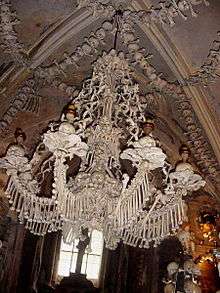Macabre




In works of art, macabre (US /məˈkɑːb/ mə-KAHB or UK /məˈkɑːbrə/; French: [makabʁ]) is the quality of having a grim or ghastly atmosphere. Macabre works emphasize the details and symbols of death. The term also refers to works particularly gruesome in nature.
History
This quality is not often found in ancient Greek and Latin writers, though there are traces of it in Apuleius and the author of the Satyricon. Outstanding instances in English literature include the works of John Webster, Robert Louis Stevenson, Mervyn Peake, Charles Dickens, Thomas Hardy, and Cyril Tourneur. In American literature notable authors include Edgar Allan Poe, H. P. Lovecraft, and Stephen King. The word has gained its significance from its use in French as la danse macabre for the allegorical representation of the ever-present and universal power of death, known in English as the Dance of Death and in German as Totentanz. The typical form which the allegory takes is that of a series of images in which Death appears, either as a dancing skeleton or as a shrunken shrouded corpse, to people representing every age and condition of life, and leads them all in a dance to the grave. Of the numerous examples painted or sculptured on the walls of cloisters or church yards through medieval Europe, few remain except in woodcuts and engravings.
The famous series at Basel originally at the Klingenthal, a nunnery in Little Basel, dated from the beginning of the 14th century. In the middle of the 15th century this was moved to the churchyard of the Predigerkloster at Basel, and was restored, probably by Hans Kluber, in 1568. The collapse of the wall in 1805 reduced it to fragments, and only drawings of it remain. A Dance of Death in its simplest form still survives in the Marienkirche at Lübeck as 15th-century painting on the walls of a chapel. Here there are twenty-four figures in couples, between each is a dancing Death linking the groups by outstretched hands, the whole ring being led by a Death playing on a pipe. In Tallinn (Reval), Estonia there is a well-known Danse Macabre painting by Berndt Notke displayed at St. Nikolaus Church (Niguliste), dating the end of 15th century. At Dresden there is a sculptured life-size series in the old Neustädter Kirchhoff, moved here from the palace of Duke George in 1701 after a fire. At Rouen in the cloister of St Maclou there also remains a sculptured danse macabre. There was a celebrated fresco of the subject in the cloister of Old St Pauls in London, and another in the now destroyed Hungerford Chapel at Salisbury, of which only a single woodcut, "Death and the Gallant", remains. Of the many engraved reproductions, the most famous is the series drawn by Holbein. The theme continued to inspire artists and musicians long after the medieval period, Schubert's string quartet Death and the Maiden (1824) being one example. In the twentieth century, Ingmar Bergman's 1957 film The Seventh Seal has a personified Death, and could thus count as macabre.
The origin of this allegory in painting and sculpture is disputed. It occurs as early as the 14th century, and has often been attributed to the overpowering consciousness of the presence of death due to the Black Death and the miseries of the Hundred Years' War. It has also been attributed to a form of the Morality, a dramatic dialogue between Death and his victims in every station of life, ending in a dance off the stage.[1] The origin of the peculiar form the allegory has taken has also been found in the dancing skeletons on late Roman sarcophagi and mural paintings at Cumae or Pompeii, and a false connection has been traced with "The Triumph of Death", attributed to Orcagna, in the Campo Santo at Pisa.
Etymology
The etymology of the word "macabre" is uncertain. According to Gaston Paris[2] it first occurs in the form "macabre" in Jean le Fèvre's Respit de la mort (1376), Je fis de Macabré la danse, and he takes this accented form to be the true one, and traces it in the name of the first painter of the subject. The more usual explanation is based on the Latin name, Machabaeorum chorea (Dance of Maccabees). The seven tortured brothers, with their mother and Eleazar (2 Maccabees 6 and 7) were prominent figures on this hypothesis in the supposed dramatic dialogues.[3] Other connections have been suggested, as for example with St. Macarius, or Macaire, the hermit, who, according to Vasari, is to be identified with the figure pointing to the decaying corpses in the Pisan Triumph of Death, or with an Arabic word maqābir (مقابر), cemeteries (plural of maqbara). Another claim is that the word "Macabre" comes from the Hebrew "מהקבר" (spelled "mhkbr" and pronounced "Mehakever"), meaning "from the grave".
See also
References
- ↑ See Du Cange, Gloss., s.v. Machabaeorum chora.
- ↑ Romania, xxiv., 131; 1895.
- ↑ The Shorter Oxford English Dictionary (Fifth edition; 2002) states that the origin of "macabre" perhaps has reference to "a miracle play containing the slaughter of the Maccabees." Volume 1, p. 1659.
External links
| Look up macabre in Wiktionary, the free dictionary. |